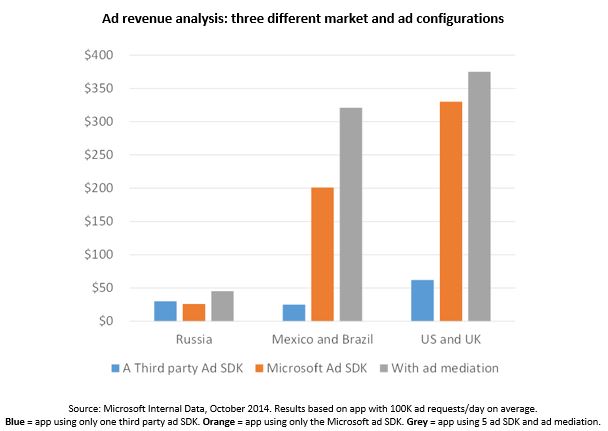One solution some developers use to increase fill rates is to deploy multiple ad networks in such a way that when one ad network is unable to deliver ad inventory, the app calls a second or third ad network, and so on to generate what is known as an impression waterfall. This waterfall approach optimizes for fill rate and can provide an increase in revenue, but takes a lot of time and experience with the SDK configuration details before coding, testing and deploying.
Announcing Windows ad mediation
Today we are announcing the availability of Windows ad mediation, a simple solution designed to help Windows Phone developers manage multiple in-app advertising SDKs. All you need to do is insert the ad mediation code into your app, select the ad networks you want to include, choose your base configuration in Dev Center and submit your app update to the Store (app update is required upon initial mediation integration only).
Windows ad mediation will help you:
- Increase ad revenue through higher fill rates
- Tailor ad experiences based on market-specific dynamics, using different ad SDKs
- Dynamically optimize ad configuration to drive the highest yield
In our testing, Windows ad mediation delivered a fill rate of over 95%, with a measurable increase in ad revenue. You can expect your results to vary based on ad network mix, target markets and timing. In the example below, we compared results from multiple ad network configurations and multiple markets. Revenue gains with ad mediation occurred in all markets, with revenue increasing 15% to 200%, depending on the market. It will be important to do testing to optimize for your markets and scenarios.
In the example below, the highest revenue was achieved using ad mediation. Even though each ad network had strengths in different markets, the combination of multiple ad SDKs delivered the best results. Below are examples of the results from 3 different markets: Russia, Mexico and Brazil, and US and UK.
In-App advertising partners
We’re also pleased to introduce our launch partners Microsoft Advertising, AdDuplex, Inneractive, and Smaato to bring you this ad mediation solution. We would highly recommend inclusion of the Microsoft Advertising SDK as it is the most commonly used ad control in Windows and Windows Phone apps and provides good monetization in many markets.
Developers can also use additional SDKs from companies like AdMob, InMobi and MobFox. Each partner ad network has varying geographic coverage and unique options, giving you flexibility to use the mix of ad networks that perform best for you.
Incentive: earn DVLUP points
As an added incentive to update your apps in time for the holiday rush, we’re offering developers who deploy Windows ad mediation the opportunity to accumulate points that can be redeemed for rewards – just by participating in a new DVLUP challenge: Boost your bottom line with ads.
I hope you’ll try this new approach to maximize your Windows Phone in-app advertising ROI. And, please do continue to give us your feedback along the way.
Make sure to read today’s post from Bernardo Zamora, providing additional background and “how to” information to get started with ad mediation. And, coming soon, tips for optimizing your app for the busy holiday selling season, along with holiday deadlines.


